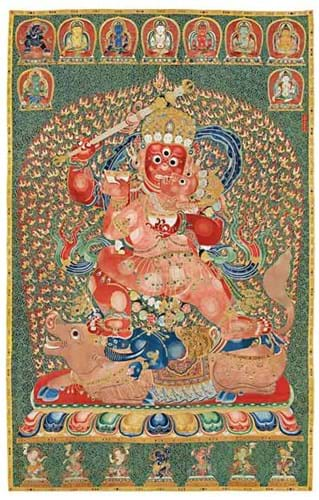This hammer price - HK$348.4m (£30.6m) with premium added - effectively counts as a new auction record for Chinese art. It also exceeds at a single stroke the aggregate of all the Oriental works of art sold at auction during the recent Asian Art in London series.
After an intense bidding battle on the phones which lasted 22 minutes, the thangka was knocked down to Liu Yiqian, the well-known Chinese collector who was bidding via the phone of Jinqing Cai, president of Christie's China. After the sale, Mr Liu said he had purchased it for his recently opened Long Museum in Shanghai.
The large 11ft x 7ft (3.35 x 2.13m) thangka - recently on view in London's King Street - was created over five centuries ago during the reign of the Ming dynasty's third ruler, the Yongle emperor who was in power from 1402-24. Embroidered in gold and brilliantly coloured silk threads, it depicts Raktayamari, the red Conqueror of Death, embracing his consort, Vajravetali.
Yongle was a devout Buddhist who became the devoted disciple of the fifth Karmapa of the Karma Kagyu lineage.
The emperor is known to have bestowed many favours and gifts on the Karmapa, and it is thought that this impressive thangka was among them. This textile came to the West in the 1940s from the small Indian state of Sikkim - a gift from the Chogyal of Sikkim, Sir Tashi Namgyal, to an English friend in the 1940s.
Remarkable Condition
Its survival in such impeccable condition is remarkable, with the vibrant embroidery considered as strong today as it was when made. Only two other similar examples are known, both of which reside in the Jokhang Monastery in Lhasa.
Christie's thangka had been consigned from an American collection and was catalogued without a published estimate at the sale on November 26.
First offered for sale in 1977 in London, it has since made two other appearances at auction and last sold at Christie's in Hong Kong in 2002 when it took a premium-inclusive HK$30.9m ($4m). At the time this was a record for any Asian textile but it is an indication of the change in the marketplace across 12 years that its value has since increased ten-fold.
The auctioneers, who this year chose not to hold a flagship sale in London, described the landmark price as "a record for any Chinese work of art sold by an international auction house" - carefully sidestepping the £43m 'sale' in November 2010 of a Qianlong famille rose vase at Surrey auctioneers Bainbridges.
The highest bidder in Ruislip famously failed to pay and not until January 2013 was it was confirmed that a sale had been brokered through Bonhams at perhaps half the hammer price or a little more.






